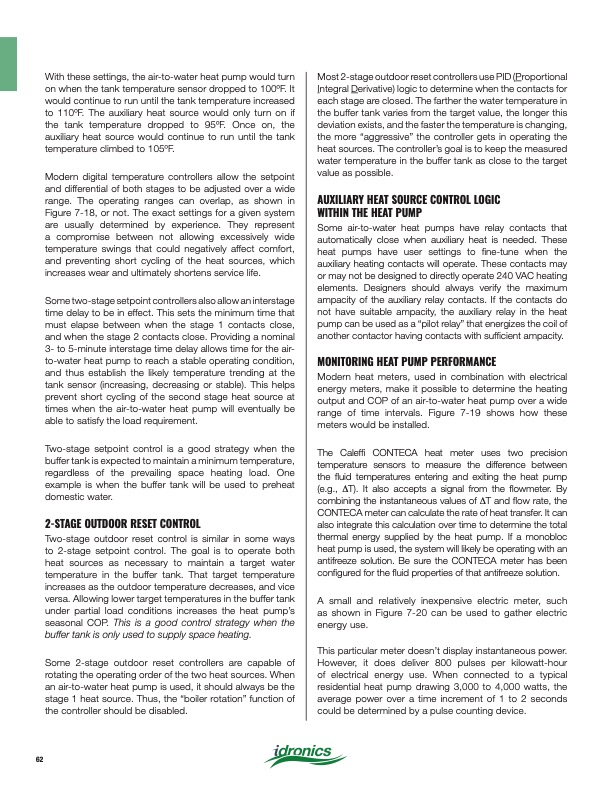
PDF Publication Title:
Text from PDF Page: 062
With these settings, the air-to-water heat pump would turn on when the tank temperature sensor dropped to 100oF. It would continue to run until the tank temperature increased to 110oF. The auxiliary heat source would only turn on if the tank temperature dropped to 95oF. Once on, the auxiliary heat source would continue to run until the tank temperature climbed to 105oF. Modern digital temperature controllers allow the setpoint and differential of both stages to be adjusted over a wide range. The operating ranges can overlap, as shown in Figure 7-18, or not. The exact settings for a given system are usually determined by experience. They represent a compromise between not allowing excessively wide temperature swings that could negatively affect comfort, and preventing short cycling of the heat sources, which increases wear and ultimately shortens service life. Some two-stage setpoint controllers also allow an interstage time delay to be in effect. This sets the minimum time that must elapse between when the stage 1 contacts close, and when the stage 2 contacts close. Providing a nominal 3- to 5-minute interstage time delay allows time for the air- to-water heat pump to reach a stable operating condition, and thus establish the likely temperature trending at the tank sensor (increasing, decreasing or stable). This helps prevent short cycling of the second stage heat source at times when the air-to-water heat pump will eventually be able to satisfy the load requirement. Two-stage setpoint control is a good strategy when the buffer tank is expected to maintain a minimum temperature, regardless of the prevailing space heating load. One example is when the buffer tank will be used to preheat domestic water. 2-STAGE OUTDOOR RESET CONTROL Two-stage outdoor reset control is similar in some ways to 2-stage setpoint control. The goal is to operate both heat sources as necessary to maintain a target water temperature in the buffer tank. That target temperature increases as the outdoor temperature decreases, and vice versa. Allowing lower target temperatures in the buffer tank under partial load conditions increases the heat pump’s seasonal COP. This is a good control strategy when the buffer tank is only used to supply space heating. Some 2-stage outdoor reset controllers are capable of rotating the operating order of the two heat sources. When an air-to-water heat pump is used, it should always be the stage 1 heat source. Thus, the “boiler rotation” function of the controller should be disabled. Most 2-stage outdoor reset controllers use PID (Proportional Integral Derivative) logic to determine when the contacts for each stage are closed. The farther the water temperature in the buffer tank varies from the target value, the longer this deviation exists, and the faster the temperature is changing, the more “aggressive” the controller gets in operating the heat sources. The controller’s goal is to keep the measured water temperature in the buffer tank as close to the target value as possible. AUXILIARY HEAT SOURCE CONTROL LOGIC WITHIN THE HEAT PUMP Some air-to-water heat pumps have relay contacts that automatically close when auxiliary heat is needed. These heat pumps have user settings to fine-tune when the auxiliary heating contacts will operate. These contacts may or may not be designed to directly operate 240 VAC heating elements. Designers should always verify the maximum ampacity of the auxiliary relay contacts. If the contacts do not have suitable ampacity, the auxiliary relay in the heat pump can be used as a “pilot relay” that energizes the coil of another contactor having contacts with sufficient ampacity. MONITORING HEAT PUMP PERFORMANCE Modern heat meters, used in combination with electrical energy meters, make it possible to determine the heating output and COP of an air-to-water heat pump over a wide range of time intervals. Figure 7-19 shows how these meters would be installed. The Caleffi CONTECA heat meter uses two precision temperature sensors to measure the difference between the fluid temperatures entering and exiting the heat pump (e.g., ∆T). It also accepts a signal from the flowmeter. By combining the instantaneous values of ∆T and flow rate, the CONTECA meter can calculate the rate of heat transfer. It can also integrate this calculation over time to determine the total thermal energy supplied by the heat pump. If a monobloc heat pump is used, the system will likely be operating with an antifreeze solution. Be sure the CONTECA meter has been configured for the fluid properties of that antifreeze solution. A small and relatively inexpensive electric meter, such as shown in Figure 7-20 can be used to gather electric energy use. This particular meter doesn’t display instantaneous power. However, it does deliver 800 pulses per kilowatt-hour of electrical energy use. When connected to a typical residential heat pump drawing 3,000 to 4,000 watts, the average power over a time increment of 1 to 2 seconds could be determined by a pulse counting device. 62PDF Image | Heat Pump Systems 2020

PDF Search Title:
Heat Pump Systems 2020Original File Name Searched:
idronics_27_na.pdfDIY PDF Search: Google It | Yahoo | Bing
CO2 Organic Rankine Cycle Experimenter Platform The supercritical CO2 phase change system is both a heat pump and organic rankine cycle which can be used for those purposes and as a supercritical extractor for advanced subcritical and supercritical extraction technology. Uses include producing nanoparticles, precious metal CO2 extraction, lithium battery recycling, and other applications... More Info
Heat Pumps CO2 ORC Heat Pump System Platform More Info
| CONTACT TEL: 608-238-6001 Email: greg@infinityturbine.com | RSS | AMP |